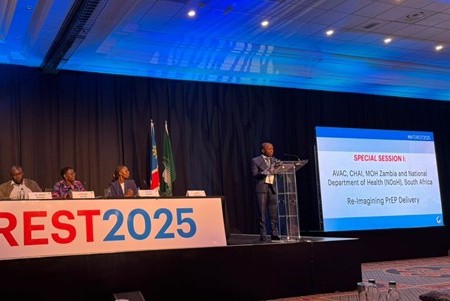Re-imagining the Future of PrEP at INTEREST 2025

The 2025 INTEREST conference in Windhoek, Namibia showcased the latest in HIV research across the continent of Africa, including the integration of HIV services with other disease areas such as tuberculosis, malaria, MPOX, and neglected tropic diseases. During a critical time for a region facing enormous challenges due to PEPFAR funding cuts, participants came together to reflect upon accomplishments to date and discuss what is needed to ensure continuation of HIV services in future.
To strategise for the future of prevention, including introduction and scale-up of new, innovative products such as cabotegravir (CAB), lenacapavir (LEN), and the dual prevention pill (DPP), AVAC co-hosted a symposium with ministries of health from Kenya, South Africa, Zambia, and Zimbabwe as well as a stakeholder dialogue featuring ministries of health, implementers, and advocates. Key takeaways and recommendations are listed below. For further details, see the symposium and stakeholder dialogue reports.
- Reframe HIV Prevention as a Core Public Health Priority
- The HIV prevention field must be repositioned to treat PrEP as a large-scale, essential intervention, not a niche or secondary service.
- Current global planning underestimates the true volume of PrEP needed. Modeling data shows that for every person who started PrEP last year, three others were newly infected—underscoring the urgent need for massive scale-up.
- Sustain Political Will and Mobilize Domestic Investment
- Sustaining political commitment is critical to keeping HIV prevention high on national agendas, especially amid shifting funding landscapes.
- Countries must prioritize domestic resource mobilization to support the scale-up of PrEP innovations and reduce dependency on external donors.
- Promote Inclusive, Evidence-Based Decision-Making
- Development of a transparent, evidence-based decision-making framework is underway to support country choices on PrEP product introduction and scale.
- Participatory governance mechanisms, such as community advisory boards, should be strengthened to ensure accountability and inclusion in national HIV prevention strategies.
- End-user involvement must be central to decision-making around product selection and service delivery to ensure options meet real-world needs.
- Expand Access Through Simplified, Integrated Service Models
- Countries should pursue simplified delivery and procurement pathways to prevent delays and inefficiencies. Lessons from South Africa highlight the risks of overly complex systems.
- Service integration is essential—HIV prevention should be embedded into maternal, newborn, child health (MNCH) and family planning platforms to reach more users efficiently.
- A user-centered approach must guide implementation, ensuring real choice among oral, injectable, and ring-based PrEP options.
- Community-friendly models are being co-developed with Ministries of Health to reflect demand for streamlined, accessible services.
- Strengthen Procurement and Regulatory Mechanisms
- Procurement processes must be cost-efficient, responsive to country needs, and support a diverse product mix.
- Existing platforms like iPlus Solutions and Wambo.net offer procurement solutions for both NGOs and governments using domestic or donor funds.
- Early regulatory engagement is essential to expedite product approvals and reduce delays in market entry.
- Enhance Coordination, Data Systems, and Implementation Research
- The Coalition to Accelerate LA PrEP has launched an online tracker to monitor progress across product introduction domains including regulatory approvals, procurement, integration, and service delivery.
- A shortlist of countries is being finalized for initial LEN PrEP volumes based on feasibility, civil society engagement, and potential for impact.
- Countries and partners are working to identify data gaps and define priority metrics to guide PrEP implementation.
- Tools from CAB and other sources are being reviewed to select context-appropriate data systems.
- Country-led implementation research should be supported to generate evidence on feasibility, acceptability, and adherence across delivery models.
- Expand Advocacy, Education, and Community Engagement
- Strong advocacy is needed to protect HIV prevention funding—particularly for key populations and adolescent girls and young women, who are at high risk and often deprioritized.
- Community awareness campaigns must be scaled up, with tailored education for young women and marginalized populations.
- Participatory governance and community involvement must remain central, with mechanisms for ongoing feedback and accountability.
- Align Globally and Act Ambitiously
- Global platforms such as the IAS Conference should be used to:
- Align on a collaborative agenda across PrEP products (LEN, DPP, MK-8527, etc.)
- Drive ambitious, coordinated action to scale access
- Mobilize political leadership and long-term investment in prevention